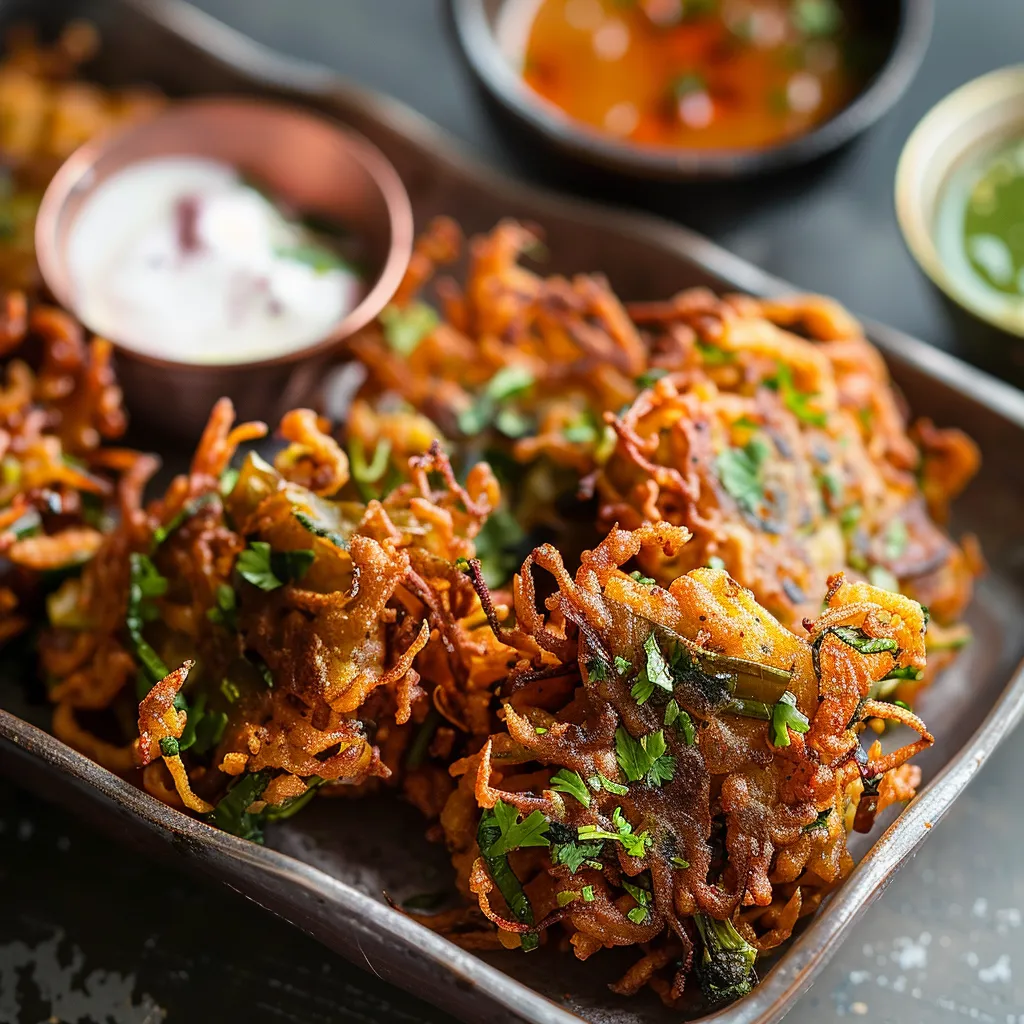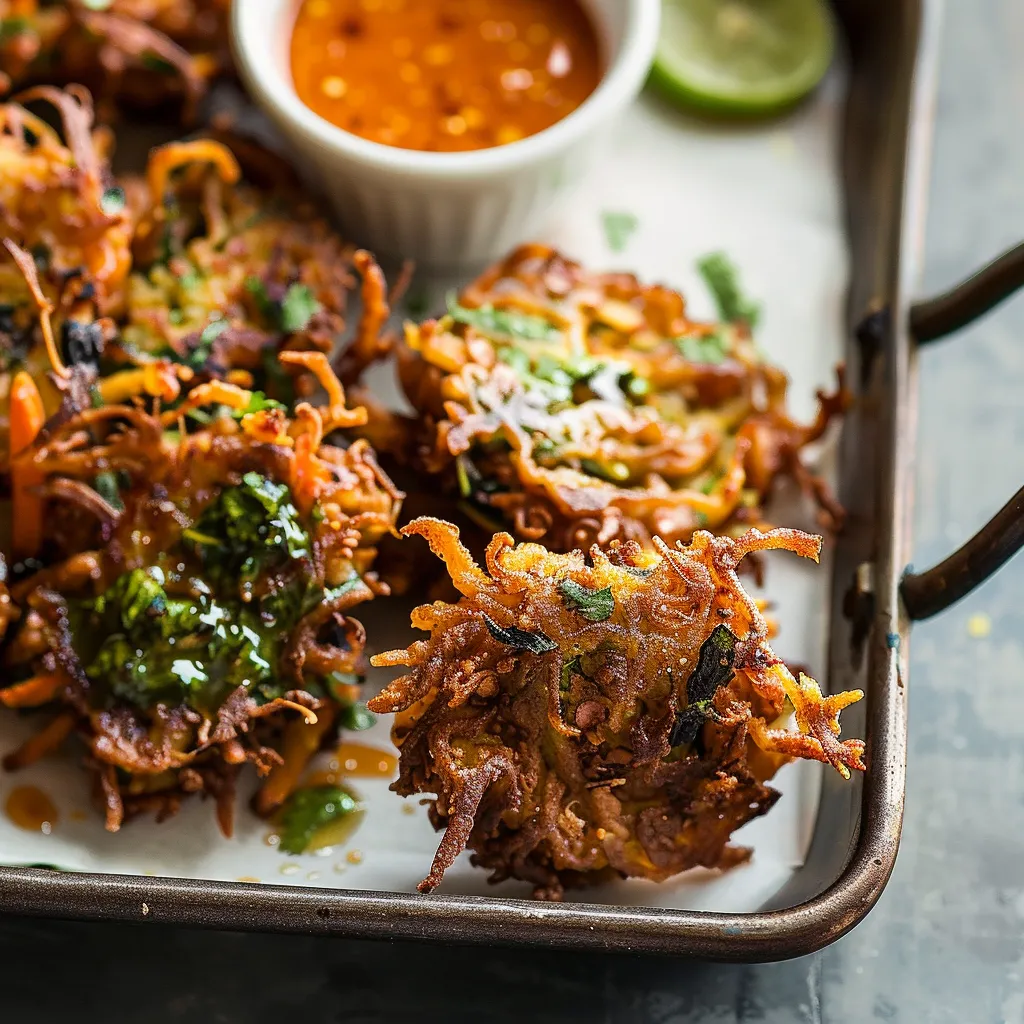 Pin it
Pin it
Indian vegetable fritters transform ordinary vegetables into extraordinary bites of crispy, spiced perfection. These pakoras bring together the earthiness of chickpea flour with aromatic spices and fresh vegetables to create something truly magical. The contrast between the golden, crunchy exterior and tender, flavorful interior makes these fritters irresistible whether served as a snack, appetizer, or accompaniment to afternoon tea.
I first encountered pakoras during monsoon season in Mumbai, where street vendors would set up their makeshift stalls as raindrops began to fall. The combination of hot, crispy fritters and steaming masala chai while raindrops pattered outside created a sensory experience I've never forgotten. After numerous attempts to recreate that perfect texture and flavor balance, this recipe consistently delivers that authentic taste of Indian comfort food.
Essential Pakora Components
- Chickpea flour: Forms traditional protein rich base
- Cornstarch: Creates ultimate crispiness when fried
- Whole cumin seeds: Release aromatic essential oils
- Coriander seeds: Provide citrusy warm notes
- Ginger garlic paste: Builds essential flavor foundation
- Dried fenugreek leaves: Add distinctive earthiness
- Kosher salt: Enhances all spices perfectly
- Celery seeds: Contribute subtle complexity
- Red pepper flakes: Add gentle warming heat
- Turmeric: Provides golden color and earthiness
- Baking soda: Creates airy lightness within fritters
- Fresh serrano chile: Contributes bright spiciness
- Chopped cilantro: Adds fresh herbal notes
- Sliced onions: Form essential vegetable base
- Julienned potatoes: Provide hearty substance
- Fresh spinach: Adds color and nutritional value
Perfect Preparation
- Spice Awakening:
- Begin by toasting whole cumin and coriander seeds in a dry skillet over medium low heat. This crucial step awakens the essential oils within the seeds, releasing their full aromatic potential. Move them continuously to prevent burning until they become fragrant and slightly darker, usually within five minutes. Using a mortar and pestle, lightly crush them just enough to release flavor while maintaining textural interest.
- Batter Foundation:
- In a large mixing bowl, combine chickpea flour and cornstarch as the base for your fritters. The combination creates the perfect texture, with chickpea flour providing authentic flavor and cornstarch ensuring maximum crispiness. Add all remaining dry ingredients including toasted spices, herbs, and seasonings, mixing thoroughly to distribute spices evenly throughout.
- Moisture Introduction:
- Add half the sliced onions and water to the dry ingredients, stirring to create a thick batter. This initial resting period with only partial vegetables serves an important purpose, allowing the onions to release their moisture gradually into the batter, creating natural liquid that produces lighter fritters than water alone would provide.
- Vegetable Integration:
- After the initial rest, incorporate remaining onions, potatoes, and spinach into the batter. Rather than simply stirring, use your hands to gently squeeze the vegetables, encouraging them to release additional moisture into the mixture. This technique creates the perfect consistency while ensuring vegetables are thoroughly coated with batter.
- Consistency Perfection:
- Assess the batter after vegetables have been fully incorporated and the second rest period. The ideal consistency resembles thick pancake batter that falls slowly from a spoon while coating the vegetables completely. Adjust with minimal additional water or chickpea flour as needed, adding in very small increments to maintain proper balance.
- Precise Frying:
- Heat oil to exactly 325°F, monitoring with a thermometer for accuracy. This moderate temperature allows fritters to cook through completely without burning the exterior. Using two spoons, form small portions of batter and carefully slide them into the oil, ensuring they enter smoothly to form compact fritters rather than spreading out.
- Controlled Cooking:
- Maintain proper oil temperature throughout cooking by adjusting heat as needed and avoiding overcrowding the pan. Flip fritters once when the submerged side has turned golden brown, allowing the second side to cook equally. The complete cooking process should take approximately six to seven minutes total for perfectly crisp exteriors and fully cooked interiors.
- Proper Draining:
- Remove finished pakoras with a slotted spoon or spider strainer, allowing excess oil to drip back into the pan before transferring to paper towels. Arrange in a single layer rather than stacking to preserve crispness, and sprinkle immediately with a small amount of salt while still hot for enhanced flavor.
 Pin it
Pin it
I particularly love making these fritters when unexpected visitors arrive, as they come together quickly yet feel special enough for company. My nephew who typically avoids vegetables devours these without hesitation, unaware he's consuming a generous serving of nutritious ingredients. The aromatic spices filling the kitchen create an atmosphere of warmth and welcome that transforms ordinary afternoons into memorable gatherings.
Perfect Pairings
Serve these golden pakoras with vibrant green cilantro mint chutney for bright, cooling contrast against the warm fritters. For sweet and tangy balance, offer tamarind date chutney alongside. Create a complete snack experience by serving with masala chai tea, allowing the spices in both the beverage and fritters to complement each other beautifully.
Creative Variations
Transform this classic recipe by incorporating different vegetables such as cauliflower florets, bell peppers, or grated zucchini for personalized variations. Create paneer pakoras by adding small cubes of Indian cottage cheese to the batter for protein rich bites. For special occasions, introduce chopped fresh herbs like mint or dill to the batter for additional flavor complexity.
Storage Solutions
While pakoras are best enjoyed immediately after cooking, leftovers can be stored in an airtight container in the refrigerator for up to two days. To revive their crispness, avoid microwave reheating which creates sogginess. Instead, place them on a baking sheet in a preheated 375°F oven for approximately ten minutes until heated through and exterior crispness returns.
 Pin it
Pin it
Frequently Asked Questions
- → What is chickpea flour and where can I find it?
- Chickpea flour (also called besan or gram flour) is made from ground dried chickpeas. It's a staple in Indian cooking that gives pakoras their distinctive flavor and crispy texture. You can find it in Indian grocery stores, international food aisles of larger supermarkets, health food stores, or online. Look for packages labeled 'besan' or 'gram flour.'
- → Can I make pakoras ahead of time?
- While pakoras are best enjoyed fresh and hot, you can make them a few hours ahead and reheat them. To crisp them up again, place in a 350°F oven on a wire rack for 5-7 minutes. The batter can also be prepared a few hours ahead and refrigerated, but you may need to adjust the consistency with a bit more chickpea flour before frying.
- → What other vegetables can I use in pakoras?
- Pakoras are incredibly versatile! Try cauliflower florets, bell pepper strips, thinly sliced eggplant, grated carrots, or zucchini. You can also make pakoras with just one vegetable instead of a mixture. Adjust the consistency of the batter as needed depending on how wet your chosen vegetables are.
- → What's a good substitute for fenugreek leaves if I can't find them?
- Dried fenugreek leaves (kasoori methi) have a unique flavor that's difficult to replicate exactly, but you can substitute with a mixture of equal parts chopped fresh celery leaves and fresh dill, or simply omit them. The pakoras will still be delicious, just with a slightly different flavor profile.
- → Can I bake or air-fry these pakoras instead of deep frying?
- While traditional pakoras are deep-fried, you can adapt them for air frying or baking. For air frying, spray the fritters with oil and cook at 370°F for about 12-15 minutes, flipping halfway. For baking, place on a parchment-lined sheet, spray with oil, and bake at 400°F for 20-25 minutes, flipping halfway. The texture won't be exactly the same as deep-fried, but they'll still be tasty.
